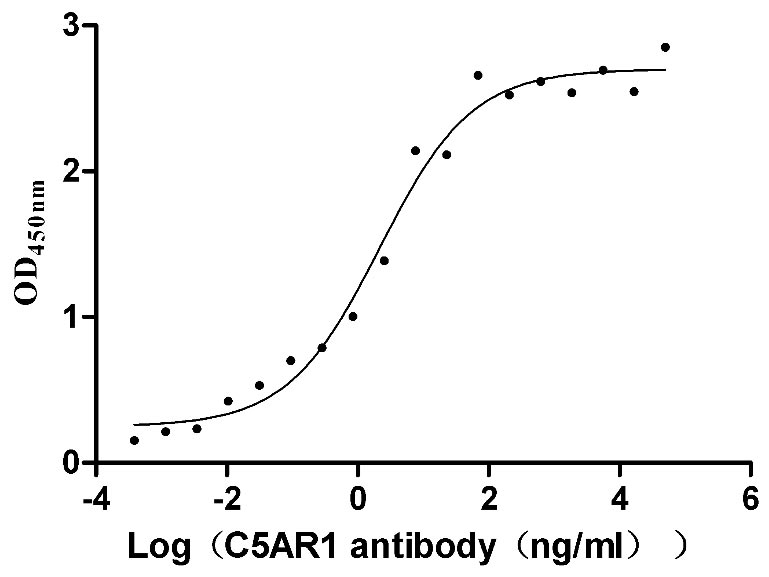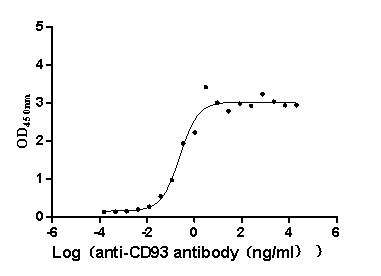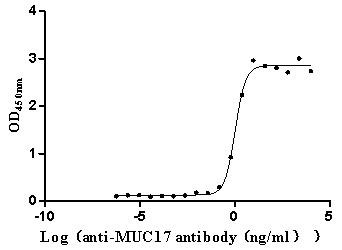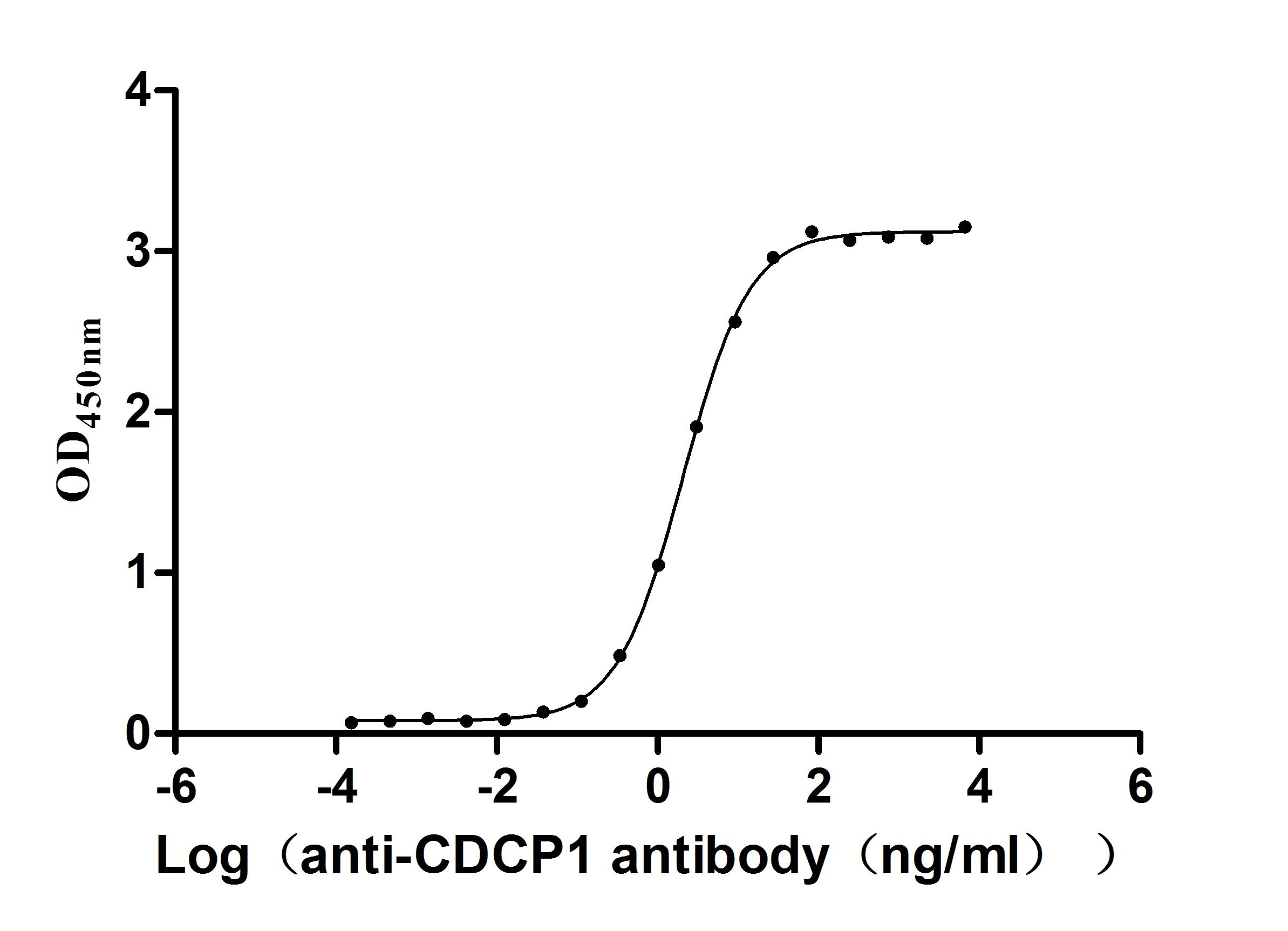Recombinant Human Melanopsin (OPN4), partial
-
中文名稱:人OPN4重組蛋白
-
貨號(hào):CSB-YP883398HU1
-
規(guī)格:
-
來源:Yeast
-
其他:
-
中文名稱:人OPN4重組蛋白
-
貨號(hào):CSB-EP883398HU1
-
規(guī)格:
-
來源:E.coli
-
其他:
-
中文名稱:人OPN4重組蛋白
-
貨號(hào):CSB-EP883398HU1-B
-
規(guī)格:
-
來源:E.coli
-
共軛:Avi-tag Biotinylated
E. coli biotin ligase (BirA) is highly specific in covalently attaching biotin to the 15 amino acid AviTag peptide. This recombinant protein was biotinylated in vivo by AviTag-BirA technology, which method is BriA catalyzes amide linkage between the biotin and the specific lysine of the AviTag.
-
其他:
-
中文名稱:人OPN4重組蛋白
-
貨號(hào):CSB-BP883398HU1
-
規(guī)格:
-
來源:Baculovirus
-
其他:
-
中文名稱:人OPN4重組蛋白
-
貨號(hào):CSB-MP883398HU1
-
規(guī)格:
-
來源:Mammalian cell
-
其他:
產(chǎn)品詳情
-
純度:>85% (SDS-PAGE)
-
基因名:
-
Uniprot No.:
-
別名:OPN4; MOP; Melanopsin; Opsin-4
-
種屬:Homo sapiens (Human)
-
蛋白長度:Partial
-
蛋白標(biāo)簽:Tag?type?will?be?determined?during?the?manufacturing?process.
The tag type will be determined during production process. If you have specified tag type, please tell us and we will develop the specified tag preferentially. -
產(chǎn)品提供形式:Lyophilized powder
Note: We will preferentially ship the format that we have in stock, however, if you have any special requirement for the format, please remark your requirement when placing the order, we will prepare according to your demand. -
復(fù)溶:We recommend that this vial be briefly centrifuged prior to opening to bring the contents to the bottom. Please reconstitute protein in deionized sterile water to a concentration of 0.1-1.0 mg/mL.We recommend to add 5-50% of glycerol (final concentration) and aliquot for long-term storage at -20℃/-80℃. Our default final concentration of glycerol is 50%. Customers could use it as reference.
-
儲(chǔ)存條件:Store at -20°C/-80°C upon receipt, aliquoting is necessary for mutiple use. Avoid repeated freeze-thaw cycles.
-
保質(zhì)期:The shelf life is related to many factors, storage state, buffer ingredients, storage temperature and the stability of the protein itself.
Generally, the shelf life of liquid form is 6 months at -20°C/-80°C. The shelf life of lyophilized form is 12 months at -20°C/-80°C. -
貨期:Delivery time may differ from different purchasing way or location, please kindly consult your local distributors for specific delivery time.Note: All of our proteins are default shipped with normal blue ice packs, if you request to ship with dry ice, please communicate with us in advance and extra fees will be charged.
-
注意事項(xiàng):Repeated freezing and thawing is not recommended. Store working aliquots at 4°C for up to one week.
-
Datasheet :Please contact us to get it.
相關(guān)產(chǎn)品
靶點(diǎn)詳情
-
功能:Photoreceptor that binds cis-retinaldehydes. Contributes to pupillar reflex, photoentrainment and other non-image forming responses to light. May be involved in the optokinetic visual tracking response. May be involved in the regulation of retinal hyaloid vessel growth and regression.
-
基因功能參考文獻(xiàn):
- Valuable insight into the structure-function relationships of human melanopsin, including several key functional residues of the melanopsin protein. The identification of melanopsin variants with significantly altered function may serve to detect individuals with disrupted melanopsin-based light perception, and potentially highlight those at increased risk of sleep disturbance, circadian dysfunction, and visual disorders. PMID: 29700553
- The wide distribution of OPN4 in central areas of the human brain evokes a question whether ambient light has important straight targets in the human brain outside the retinohypothalamic tract. PMID: 27690288
- Trait-like individual differences in the melanopsin phototransduction circuitry contribute to individual differences in sleep timing. Blue light-sensitive young individuals are more prone to delayed sleep. PMID: 27091519
- The light-induced FOS response in melanopsin expressing HEK-293 cells is correlated with melanopsin quantity and dependent on light duration and irradiance. PMID: 24909488
- By broadening the tuning of intrinsically photosensitive retinal ganglion cells, melanopsin tristability produces signal integration. PMID: 25741728
- The response of the human pupil to the separate stimulation of the cones and melanopsin at a range of temporal frequencies under photopic conditions, was measured. PMID: 25313040
- Studied OPN4*Ile394Thr gene polymorphism in association with sleep/wake timing. PMID: 24887407
- The results of this study showed that the post illumination pupil response varied on the basis of OPN4 I394T genotype among individuals with seasonal affective disorder. PMID: 23809464
- Studied the association between melanopsin gene polymorphism and pupillary light reflex under diverse photic conditions, including different intensities and wavelengths. PMID: 24119231
- A comparison of melanopsin with the mechanisms documented for vertebrate (bovine) and invertebrate (squid) visual photoreceptors shows that such a mechanism is not affected by the diversity of the three chromophore cavities. PMID: 24449866
- Significant interaction between the genotype of I394T (TT versus TC+CC) and luminance levels was found in pupil size. PMID: 23555953
- An action spectrum for the calcium response in cells expressing human melanopsin had the predicted form for an opsin : vitamin A1 pigment and peaked at 479 nm. The G-protein selectivity and spectral sensitivity of human melanopsin is similar to that previously described for rodents. PMID: 23554393
- the results indicate that ectopic expression of human OPN4 in orexin neurons enables long-lasting activation of orexin neurons by blue light to control sleep/wakefulness of the mice. PMID: 22868039
- These results suggest that the P10L TT genotype of melanopsin interacts with daylength to predispose individuals to vary in sleep onset and chronotype as a function of daylength. PMID: 22881342
- The relative contribution of melanopsin and visual photoreceptors are assessed by comparing pupillary light reflex responses in a totally visually blind patient with normally sighted individuals. PMID: 23055493
- Melanopsin and mechanisms of non-visual ocular photoreception PMID: 22074930
- The recent advances in the emerging roles of melanopsin and intrinsically photosensitive retinal ganglion cells, are reviewed. PMID: 20810319
- melanopsin acts as a sensory photopigment, coupled to a native ion channel via a G-protein signalling cascade, to drive physiological light detection PMID: 15674244
- an anatomically distinct population of 'giant', melanopsin-expressing ganglion cells in the primate retina that, in addition to being intrinsically photosensitive, are strongly activated by rods and cones PMID: 15716953
- Regulation of melanopsin expression [review] PMID: 16687290
- HEK293 cells stably expressing melanopsin have proven to be a useful tool to study melanopsin-initiated signaling. PMID: 16961436
- Data show that Seasonal Affective Disorder participants have a higher frequency of the melanopsin (OPN4) homozygous minor genotype (T/T) for the missense variant rs2675703 (P10L) than controls, compared to the combined frequencies of C/C and C/T. PMID: 18804284
顯示更多
收起更多
-
亞細(xì)胞定位:Cell membrane; Multi-pass membrane protein. Cell projection, axon. Cell projection, dendrite. Perikaryon.
-
蛋白家族:G-protein coupled receptor 1 family, Opsin subfamily
-
組織特異性:Expressed in the retina.
-
數(shù)據(jù)庫鏈接:
Most popular with customers
-
Recombinant Human HLA class II histocompatibility antigen gamma chain (CD74), partial (Active)
Express system: Mammalian cell
Species: Homo sapiens (Human)
-
Recombinant Macaca mulatta Microtubule-associated protein tau (MAPT) (Active)
Express system: Mammalian cell
Species: Macaca mulatta (Rhesus macaque)
-
Recombinant Human C5a anaphylatoxin chemotactic receptor 1 (C5AR1)-VLPs (Active)
Express system: Mammalian cell
Species: Homo sapiens (Human)
-
Recombinant Human G-protein coupled receptor family C group 5 member D (GPRC5D)-VLPs (Active)
Express system: Mammalian cell
Species: Homo sapiens (Human)
-
Recombinant Human Somatostatin receptor type 2 (SSTR2)-VLPs (Active)
Express system: Mammalian cell
Species: Homo sapiens (Human)
-
Recombinant Macaca fascicularis CD93 molecule (CD93), partial (Active)
Express system: Mammalian cell
Species: Macaca fascicularis (Crab-eating macaque) (Cynomolgus monkey)
-
Recombinant Human Mucin-17 (MUC17), partial (Active)
Express system: Mammalian cell
Species: Homo sapiens (Human)
-
Recombinant Macaca fascicularis CUB domain containing protein 1 (CDCP1), partial (Active)
Express system: Mammalian cell
Species: Macaca fascicularis (Crab-eating macaque) (Cynomolgus monkey)


-AC1.jpg)

















